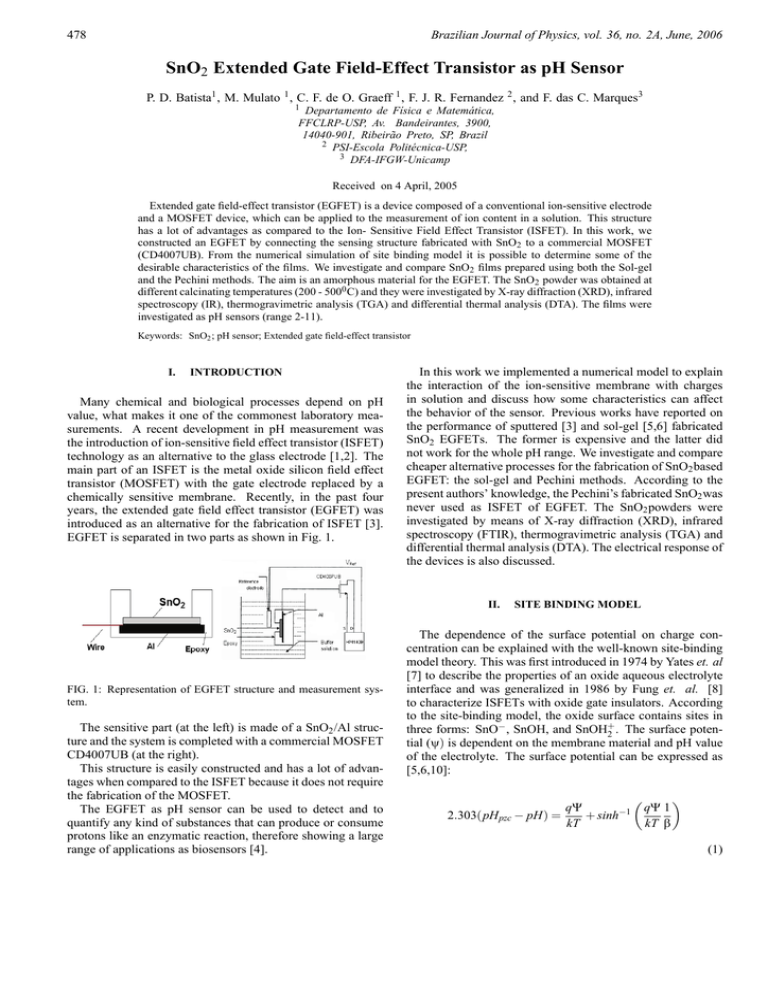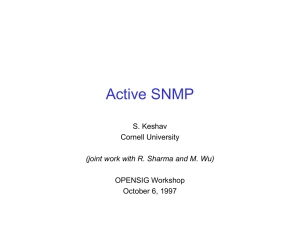SnO2 Extended Gate Field-Effect Transistor as pH Sensor
advertisement

478 Brazilian Journal of Physics, vol. 36, no. 2A, June, 2006 SnO2 Extended Gate Field-Effect Transistor as pH Sensor P. D. Batista1 , M. Mulato 1 , C. F. de O. Graeff 1 , F. J. R. Fernandez 2 , and F. das C. Marques3 1 Departamento de Fı́sica e Matemática, FFCLRP-USP, Av. Bandeirantes, 3900, 14040-901, Ribeirão Preto, SP, Brazil 2 PSI-Escola Politécnica-USP, 3 DFA-IFGW-Unicamp Received on 4 April, 2005 Extended gate field-effect transistor (EGFET) is a device composed of a conventional ion-sensitive electrode and a MOSFET device, which can be applied to the measurement of ion content in a solution. This structure has a lot of advantages as compared to the Ion- Sensitive Field Effect Transistor (ISFET). In this work, we constructed an EGFET by connecting the sensing structure fabricated with SnO2 to a commercial MOSFET (CD4007UB). From the numerical simulation of site binding model it is possible to determine some of the desirable characteristics of the films. We investigate and compare SnO2 films prepared using both the Sol-gel and the Pechini methods. The aim is an amorphous material for the EGFET. The SnO2 powder was obtained at different calcinating temperatures (200 - 5000 C) and they were investigated by X-ray diffraction (XRD), infrared spectroscopy (IR), thermogravimetric analysis (TGA) and differential thermal analysis (DTA). The films were investigated as pH sensors (range 2-11). Keywords: SnO2 ; pH sensor; Extended gate field-effect transistor I. INTRODUCTION Many chemical and biological processes depend on pH value, what makes it one of the commonest laboratory measurements. A recent development in pH measurement was the introduction of ion-sensitive field effect transistor (ISFET) technology as an alternative to the glass electrode [1,2]. The main part of an ISFET is the metal oxide silicon field effect transistor (MOSFET) with the gate electrode replaced by a chemically sensitive membrane. Recently, in the past four years, the extended gate field effect transistor (EGFET) was introduced as an alternative for the fabrication of ISFET [3]. EGFET is separated in two parts as shown in Fig. 1. In this work we implemented a numerical model to explain the interaction of the ion-sensitive membrane with charges in solution and discuss how some characteristics can affect the behavior of the sensor. Previous works have reported on the performance of sputtered [3] and sol-gel [5,6] fabricated SnO2 EGFETs. The former is expensive and the latter did not work for the whole pH range. We investigate and compare cheaper alternative processes for the fabrication of SnO2 based EGFET: the sol-gel and Pechini methods. According to the present authors’ knowledge, the Pechini’s fabricated SnO2 was never used as ISFET of EGFET. The SnO2 powders were investigated by means of X-ray diffraction (XRD), infrared spectroscopy (FTIR), thermogravimetric analysis (TGA) and differential thermal analysis (DTA). The electrical response of the devices is also discussed. II. FIG. 1: Representation of EGFET structure and measurement system. The sensitive part (at the left) is made of a SnO2 /Al structure and the system is completed with a commercial MOSFET CD4007UB (at the right). This structure is easily constructed and has a lot of advantages when compared to the ISFET because it does not require the fabrication of the MOSFET. The EGFET as pH sensor can be used to detect and to quantify any kind of substances that can produce or consume protons like an enzymatic reaction, therefore showing a large range of applications as biosensors [4]. SITE BINDING MODEL The dependence of the surface potential on charge concentration can be explained with the well-known site-binding model theory. This was first introduced in 1974 by Yates et. al [7] to describe the properties of an oxide aqueous electrolyte interface and was generalized in 1986 by Fung et. al. [8] to characterize ISFETs with oxide gate insulators. According to the site-binding model, the oxide surface contains sites in three forms: SnO− , SnOH, and SnOH+ 2 . The surface potential (ψ) is dependent on the membrane material and pH value of the electrolyte. The surface potential can be expressed as [5,6,10]: 2.303(pH pzc − pH) = qΨ + sinh−1 kT µ qΨ 1 kT β ¶ (1) P. D. Batista et al. 479 2q2 NS (Kb /Ka )1/2 β= kTCDL (2) where NS is total number of surface sites per unit area, Ka and Kb are equilibrium constants of acid point and base point respectively, and CDL is a simple capacitance derived by the Gouy-Chapman-Stern model. The site-binding model can be combined to the physics of the MOSFET (as model LEVEL 1 in SPICE [9]). The result is an expression for the ISFET drain-source current (IDS ), where the modified threshold voltage (VT ) depends on pH value. For the saturation region: ¤ 1 £ IDS = Kn (VGS −VT )2 2 300 Surface Potential (mV) where pH pzc is the pH value at the point of zero charge, k is Boltzmann’s constant, T is the temperature of the system, and β is a parameter which reflects the chemical sensitivity of the gate insulator and is dependent on the density of surface hydroxyl groups. It is given by: SnO2 by Thermal Evaporation 200 N S = 5x10 -100 N S = 5x10 -200 7 7 Ns = 5 x 10 9 Ns = 5 x 10 11 Ns = 5 x 10 13 Ns = 5 x 10 -300 0 2 4 6 8 10 FIG. 2: Numerical simulation using site binding model of surface potential of tin oxide membrane versus pH value for different values of surface sites (NS ) using available parameters for thermally evaporated SnO2 [10]. 100 Source Drain Current ( A) where Kn is the conduction parameter, VGS the source gate voltage. VT can be expressed as: 12 pH value pH = 2.0 (4) -4 0 and for the linear region: ¸ · 1 IDS = Kn (VGS −VT ) − VDS 2 -7 Kb= 1.11x10 T = 300 K C dl= 20 F 100 -400 (3) increasing pH 80 60 40 pH = 12.0 Ns = 5.0 x 10 14 cm -2 20 pH = 2, 4, 6, 8, 10 and 12 VT = VT M − ΦM /q + ERe f + χSol − Ψ 0 (5) where VT M is the MOSFET’s threshold voltage, Ere f is the potential of the reference electrode, χSol is the electrolyteinsulator surface dipole potential, ΦM is the work function of the metal gate (reference electrode) relative to vacuum [2]. In equation (5) all the parameters, with the exception of the surface potential, can be considered as a constant. So the threshold voltage depends only on the pH of the solution according to equation (1). III. Ka= 8x10 13 SIMULATION OF SURFACE POTENTIAL The relationship between surface potential of a SnO2 membrane and pH values was simulated from equations (1) and (2) and as is shown in Fig. 2. The shape of the curves depend on NS . The larger the NS , the higher the pH sensitivity, and the more linear the response. 0 1 2 3 4 5 Source Drain Voltage (V) FIG. 3: Numerical simulation for ISFET. IDS versus VDS for varying pH values. For a large NS = 5 x 1014 cm−2 , the theoretical response of the device would be as presented in Fig. 3. Note that, for instance, variations of NS could be associated to the structure of the SnO2 film: increasing NS values would be obtained from crystalline to amorphous material [11,12]. In summary, according to the numerical simulation, the optimized EGFET device should be fabricated using amorphous SnO2 . Nevertheless, up to date, most of the published works related to SnO2 material properties deal with the crystalline phase only. 480 Brazilian Journal of Physics, vol. 36, no. 2A, June, 2006 SnO2 by Sol-Gel 100 15 Mass Loss (%) 80 0 DTA 60 -15 40 -30 TGA 20 0 Temperature Difference ( oC) IV. -45 0 100 -60 600 200 300 400 500 o Temperature (C) FIG. 4: TGA/DTA analysis for Sol-gel SnO2 . EXPERIMENTAL PROCEDURE In order to explore cheap and alternative SnO2 EGFET fabrication processes, aluminum foils (1 mm-thick) were used as substrates. The SnO2 was obtained by two methods: i) sol-gel [13] [8.37g of SnCl2 H2 O are dissolved in 100 ml of absolute ethanol. This mixture is stirred and heated in reflux system at 80o C for 2 hours] and ii) Pechini [14] [citric acid (60o C) + Ethylene Glycol + Tin Citrate +HNO3 (90o C)]. Films were produced on the Al foils using brushing and calcination. In order to accurately define the temperature at which the crystallization process begins and the purity of the material, the solution (TGA/DTA and FTIR) and final SnO2 powder (FTIR and XRD) were investigated. The electrical response of the sensor was measured using varying pH solutions and the curves were obtained by a HP4140B parameter analyzer. Mass loss (%) 20 0 80 60 -20 DTA -40 TGA 40 -60 20 -80 0 0 100 200 300 400 500 o Temperature ( C) Transmitance (arb. units) SnO 2 by Pechini 100 Temperature Difference (oC) Tin Oxide powder by Sol-Gel o 300 C o 200 C o 25 C 4000 3000 600 FIG. 5: TGA/DTA analysis for Pechini’s SnO2 . 2000 1000 -1 Wavenumber (cm ) FIG. 7: FTIR for Sol-Gel SnO2 solution (bottom curve) and calcinated at different temperatures. 1,8 Powder Tin Oxide by Sol-Gel Intensity (arb. units) o (b) T = 300 C o (c) T = 400 C o (d) T = 500 C Souce Drain Current (mA) o (a) T = 200 C pH = 2 1,6 1,4 1,2 pH = 11 1,0 SnO 2 EGFET o 0,8 Pechini at 450 C 0,6 VGS = 3V 0,4 0,2 increasing pH values of 2, 4, 6, 8, 10 and 11 0,0 15 20 25 30 35 40 45 50 55 60 65 70 75 2 (degrees) FIG. 6: XRD for sol-gel SnO2 fabricated at (a) 200 (b) 300 (c) 400 and (d) 500o C. 0 1 2 3 4 Source Drain Voltage (Volts) 5 FIG. 8: Non-optimized response of a SnO2 EGFET produced by Pechini at 450o C. P. D. Batista et al. 481 40 1/2 ( A ) 39 Square root of I DS 38 37 VDS = 3 V 36 35 2 4 6 8 10 12 pH value FIG. 9: Sensitivity of the pH sensor: linear response from pH=2 up to 10 in the saturation region. V. RESULTS The TGA/DTA results for the sol-gel SnO2 solution are shown in Fig 4. Evaporation of several different species can be observed trough three slope changes on the curve. The weight loss above 1000 C may come from the condensation of remaining hydroxyl (SnOH) groups [13]. No appreciable weight change appears at temperatures exceeding 300o C. The TGA/DTA results for the Pechini’s SnO2 solution are shown in Fig. 5. An exothermic peak is observed above 400o C, associated to the crystallization of the material. The organic compounds are removed from the SnO2 sample above 300o C for the sol-gel process and above 450o C for the Pechini process. However, crystallization also occurs at 400o C for Pechini’s method. In this sense, pure and amorphous SnO2 material cannot be obtained by this process. XRD analysis were performed for both cases. The films [1] M. Yunqing, C. Jianrong, and F. Keming, J. Biochen. Biophys. Methods (2005) in press. [2] P. Bergveld, Sens. and Actuators B 88, 1 (2003). [3] L.-L. Chi, J.-C. Chou, W.-Y. Chung, T.-P. Sun, and S.-K Hsiung. Materials Chemistry and Physics 63, 19 (2000). [4] M.J. Schöning and A. Poghossian, The Analyst, 127, 1137 (2002). [5] J.-C. Chou and Y.-F. Wang. J. Appl Phys 41, 5941 (2002). [6] J.-C. Chou, P.-K., and Z-Jie Chen. J. Appl Phys 42, 6790 (2003). [7] D. E. Yates, S. Levine, and T.W. Healy. J. Chem. Soc. Fraday Trans. 1, (1974). [8] C. D. Fung, P. W. Cheung, and W.H. Ko, IEEE Trans. Electron Devices ED-33 1, 8 (1986). produced by Pechini are crystalline above 400o C (not shown here due to the lack of space). We present only the results for the sol-gel in Fig. 6. It can be observed that amorphous material can be obtained below 300o C. Nevertheless, the material is not as pure as desired, as can be seen by the FTIR data shown in Fig. 7. The SnO2 absorption band is located close to 500 cm−1 , while the others correspond to water and organic compounds [15]. It can be observed that while the band at 1000cm−1 disappears at 200o C, the other at 3500cm−1 remains noticeable even at 300o C. This confirms the TGA/DTA suggestion that the amorphous material is not pure. Fig. 8 shows the SnO2 EGFET characterization for a nonoptimized film produced by Pechini at a calcination temperature of 450o C. The drain-current versus source-drain voltage is presented for varying pH concentrations from 2 up to 11. The sensitivity of the sensor in the saturation region, based on equation 3 is presented in Fig. 9. A linear response is observed from pH values 2 to 10. VI. CONCLUSIONS We used the sol-gel and Pechini’s process to develop SnO2 EGFET pH sensors. Both are cheaper and easier than common thin film techniques. The sol-gel fabricated devices did not succeed for processing temperatures below 300o C, perhaps because of contamination by remaining organic compounds. The non-optimized Pechini’s sensors, fabricated above 450o C, have interesting linear response for pH values from 2 up to 10. The lowering of the processing temperature and the consequent fabrication of pure amorphous material would increase the number of surface sites, and lead to the final optimum device in the future. Acknowledgements This work was supported by FAPESP (01/08221-9, 03/08471-0), CAPES and CNPq, Brazil. We thank Prof. P. Olivi and Prof. J.M. Rosolen. [9] P. Antognetti and G. Massobrio, Semiconductor Device Modeling with SPICE (1988). [10] H.-K Liao, Li-Lun Chi, J-C Chou, W-Y Chung, T-P Sun, and S-K H, Mat. Chem. and Phys. 59, 6 (1999). [11] D.-H Kwon, B.-W Cho, C.-S. Kim, and B.-K. Shon, Sens. and Actuators B 34, 441 (1996). [12] H.-K. Liao, J.-C. Chou, W.-Y. Chung, T.-P. Sun, and S.-K. Hsiung, Sens. and Actuators B 65, 23 (2000). [13] J. P. Chatelon, C. Terrier, and J.A Roger, Journal of Sol-Gel Science and Technology 10 (1997). [14] E.C.P.E Rodrigues and P. Olivi, J. of Physics and Chemistry of Solids 64, 1105 (2003). [15] P. Siciliano, Sensors and Actuators B 70, 153 (2000).



